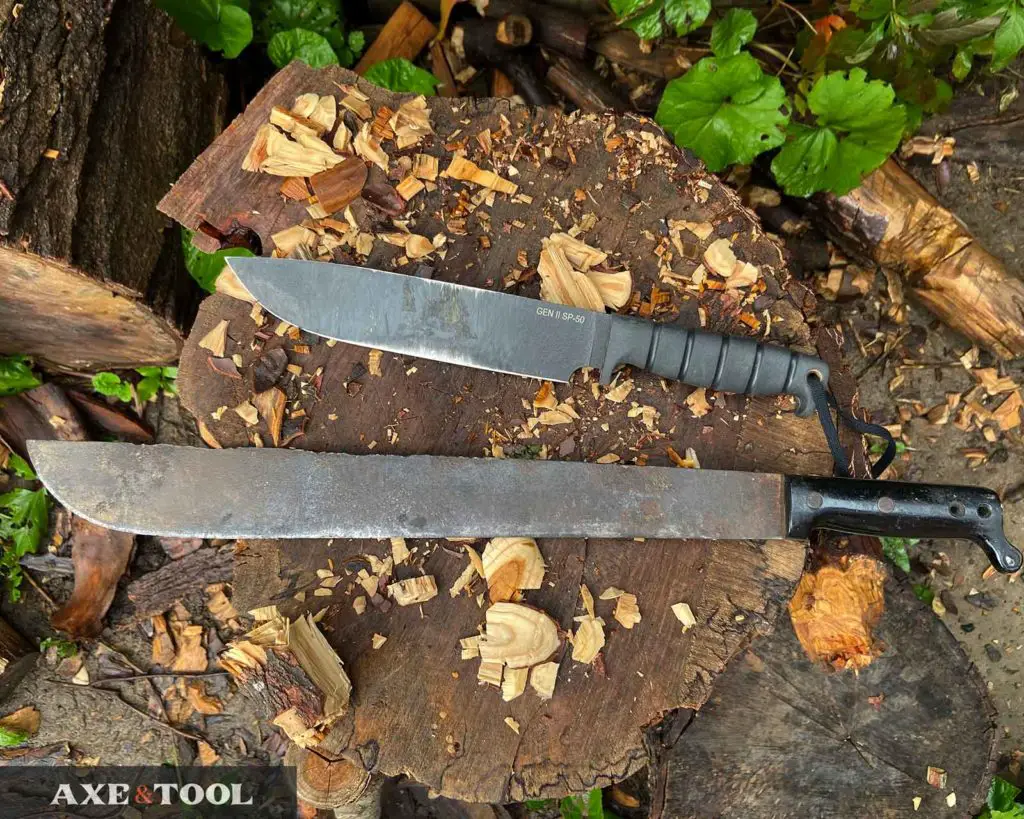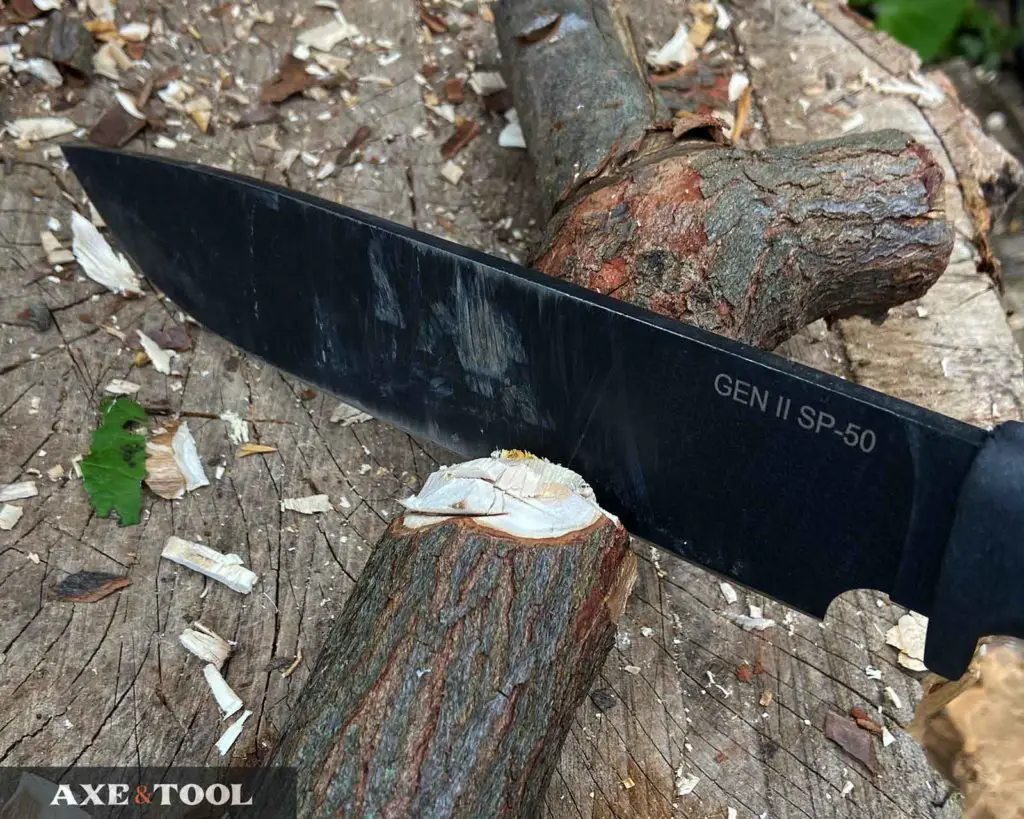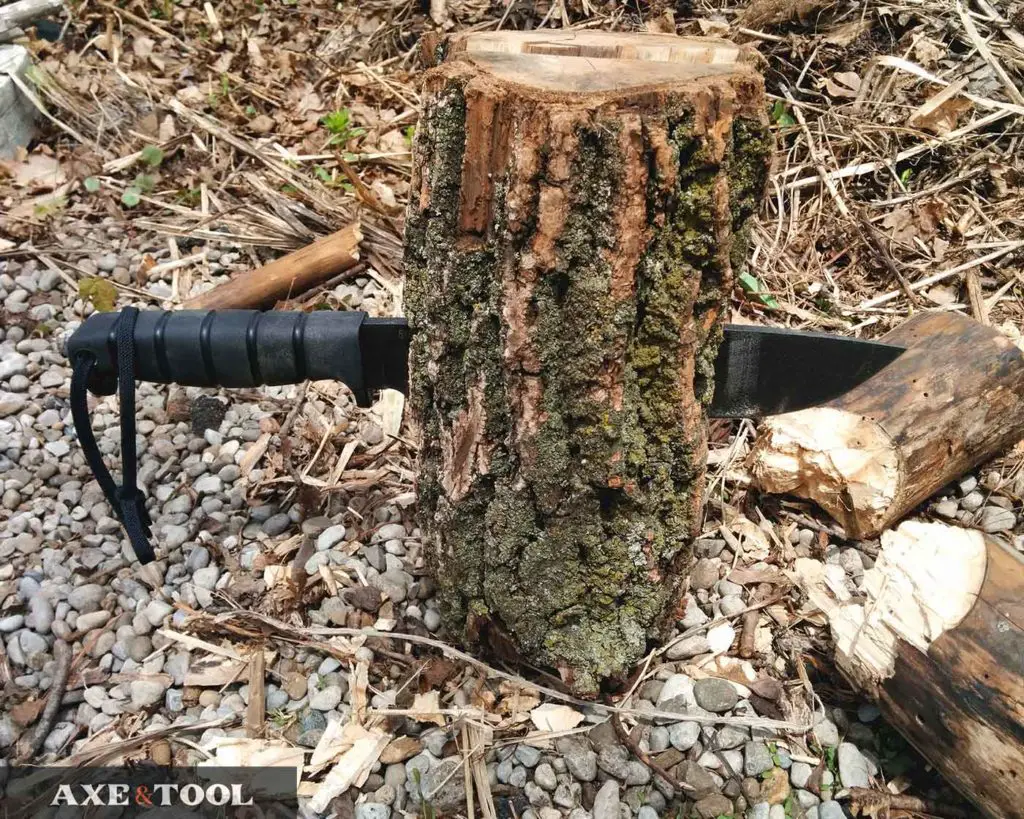Can a Machete Chop Wood?

I think there is often a little confusion on what a machete is, and what it can do – like can a machete chop wood?
A machete should not be used to chop wood or trees. The thin blade is designed to slice through brush but can get stuck, bend, or even break in thick limbs. Large outdoor knives, with a thicker spine (1/4” or more) can be used for chopping and even splitting wood, as well as brush clearing.
Machetes are for Brush
A machete can be a great addition to your kit in the backcountry as a lightweight way to get through thick brush and bramble.
An axe is pretty useless against thick undergrowth, but a machete uses its long thin cutting edge to cut lots of little branches, foliage, and vines with a single stroke. It will either slice through them on impact or as they are dragged along the blade.
A machete should be kept very sharp to cut through light branches and foliage that would otherwise just move with the impact of the blade. Typically around a 20-degree angle.
A machete will cut into wood but it’s not the right tool for heavy chopping. The thin blade won’t cut very deep. The aggressive cutting edge required to cut through brush will dull or be damaged on wood (it’s like trying to chop with a large kitchen knife).
If you do sink the blade into the wood, it can get pinched as the pressure from the tree or log is going to seal onto the flat-sided blade.
So a machete will be inefficient and is much more likely to be damaged if you try to chop wood, but you can get large outdoor (or survival) knives that are capable.
Machetes vs Large Outdoor Knives

A machete is easy to spot as it will have a long and thin blade. The blades are between 14”-22” long, and the spine (thickness of the blade) is only 1/16″ to 1/12″ of an inch (2-3mm). There can be a bulbous tip at the end to add a little extra weight at the end, giving it more inertia.
A large outdoor knife will be between 7-12” long, and have a thick spine between 1/6″ – 1/4″ (4-6mm). The cutting edge will have a wider cutting angle (over 20-degrees) that is durable enough to be used on large wood without dulling or breaking too quickly.
The extra weight and strength in the blade and cutting edge make these knives capable of chopping branches, felling small trees, and even splitting wood with the right technique (read on for methods).
These large knives can still be used to clear undergrowth and foliage, even though they aren’t quite as long as a machete, and the cut wider cutting edge won’t clear it as efficiently.
Machete, Knife, Axe or Saw?
Consider carefully, what is the best tool for your environment and what tasks you are actually going to perform.
In North America, I would only ever really consider a machete if I was deliberately clearing a trail through a lot of brush. And a machete is light enough to be paired with an axe so you can handle both tasks.
A large knife is best paired with a saw and could be a great combo for bushcraft, backpacking, or survival kits. It’s a very versatile pair that I have carried many times. But, if I know I’m going out with the intent of doing chopping or splitting work, I will take a hatchet.
The way to choose between bringing a hatchet or a large knife is which will be the bigger pain in the ass; carrying the extra weight of an axe, or doing the work with a knife.
How to use a large knife to chop wood

Chopping with a large knife is similar to using a hatchet. Don’t chop straight into the log or tree, swing at an angle so you can chop out a notch.
You can pretty easily work your way around the branch until the notch is big enough to let you break through with a well-placed blow.
How to use a large knife to split wood
There are two ways you can split wood with a knife. But both these methods are best suited for the knife-saw combo.
Battoning
This method is good for quickly breaking down one or two pieces of wood into kindling, but I wouldn’t want to do this in any large volume.
The width of the log needs to be shorter than the length of the knife by an inch or two).
- Stand your log up
- Hold the knife if your off-hand, pressing down where you want to split the log.
- Grab a stick or another log in your free hand to use as a mallet.
- Repeatedly hammer the end of the knife with the “mallet”, driving it through the log. Apply pressure on the knife the whole time while you pound it through.

This works surprisingly well, BUT if you are out in the wilderness, it may not be what you want to use.
1. Battoning can be hard on a knife, but the edge and the tip. If you are relying on this knife you might not want to add any extra risk of putting it out of commission.
2. If you take on a particularly large or tough log you might get into trouble. Your knife can get stuck and then you’re in a real bind. Fortunately, the next method can help for your knife or just be used to split logs on its own.
Making a wood splitting wedge with a knife
You can split much bigger logs with a much smaller knife if you do this right.
Simply make splitting wedges out of wood, and never need to beat on your knife.
You will need a hardwood log that’s 2″-3″ across, cut to a length of around 8″-10″. It doesn’t matter what kind of hardwood, but it can’t be a softwood (evergreen tree).
- Using your knife, shape your wedge out of the hardwood log, with the slopes around 4″ long down to the point. You need the extra 4″+ to hold onto while you split.
- Using your knife or saw make a small notch or groove in the top of the log you want to split. It can be as simple as one good chop of a knife.
- Place the point of the wedge in that notch
- Repeatedly hammer the wedge with another stick, until the log splits.

What’s handy is once you have the wedge it can be used many times, often without even fixing the edge. And if you make multiple wedges it’s even possible to split some pretty big pieces of wood.
This wedge method can also be used to free a knife stuck while battoning, or to split larger logs if you only have a hatchet.
Please comment below If I missed something or if you have any questions. I do my best to respond to everyone.
About the author:
About the author:
Jim Bell | Site Creator
I’m just a guy who likes axes. I got tired of only finding crap websites, so I set out to build a better one myself.
I’m also on Instagram: @axeandtool


